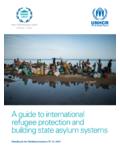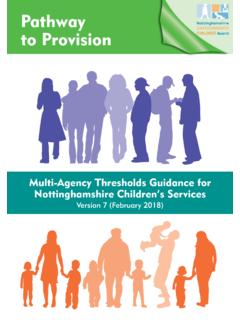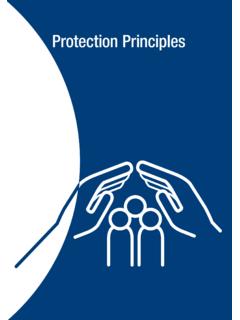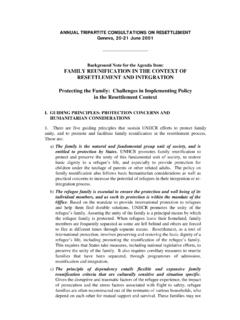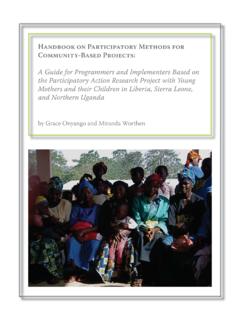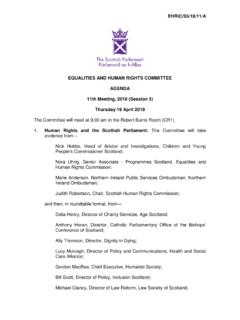Transcription of UNHCR Protecting Children of Concern through a …
1 01 December 2010 Protecting Children of Concern through a Systems Approach: Guidance for Field Offices01 December 2010 Contents Chapter 1: Introduction 1. Background 2. Purpose of Handbook 3. Who is the Handbook intended for? 4. Contents of the Handbook Chapter 2: child protection 5. What child protection risks do Children of Concern to UNHCR face? 6. Who is responsible for Protecting Children ? 7. Why do we need a child protection System? 8. What is a child protection System? 9. What are the key components of a child protection System? 10. Core Principles Chapter 3: The Matrix 11. The operational context of UNHCR s work 12. How to Use the Matrix and Action Sheets 13. Matrix Chapter 4: The Action Sheets Action Sheets Annexes 01 December 2010 Chapter 1 Introduction to the Handbook 1. Background Almost half of the population of Concern to UNHCR are Children .
2 More importantly, Children have special protection needs that require specific prevention and response strategies to ensure their rights and to preserve their safety and physical and psychological well-being. For the purposes of the Handbook, the definition of child protection equates to all forms of abuse (psychical, sexual and mental), neglect, exploitation and violence. child protection is a component of the broader UNHCR protection mandate. During conflicts and other humanitarian emergencies, the risks of child protection violations increases. At the same time, existing safeguarding mechanisms, including those of family and community, often break down and basic social services can become sporadic, fragmented or cease altogether. Yet, refugee and other displaced Children are first and foremost Children and, as such, should, regardless of their status, be safeguarded through systems established to contribute to their protection Since the UNHCR Executive Committee adopted the first thematic Conclusion on Refugee Children in 1987,1 the need to enhance the protection and care of Children falling under UNHCR s mandate has been a matter of increasing awareness and Concern within the Organization.
3 This has prompted the development of strategy, guidelines and protocols to promote such care. In 1988, UNHCR published the UNHCR Guidelines for Refugee Children and in 1993 UNHCR adopted a Policy on Refugee Children . This policy specifically set out principles and objectives to inform the discharge of UNHCR s responsibilities vis- -vis Children and acknowledges that their protection and care is central to the fulfilment of UNHCR s mandate. In 1994, the revised UNHCR , Guidelines on the protection and Care of Refugee Children 2, used the Convention on the Rights of the child (CRC) as a conceptual framework providing important and comprehensive guidance to address a wide spectrum of protection issues affecting refugee Children . The importance of addressing child protection from a holistic perspective was underscored by the UN Secretary-General s Study on Violence against Children ,3 which recommended that a systematic and multifaceted framework be developed to respond to violence against Children .
4 The 2006, Decision on the Five Global Priorities for Refugee Children , by UNHCR s Standing Committee also acknowledged that a systematic approach to the protection of refugee Children is required. It encouraged UNHCR to enhance its partnership with child protection agencies, to build a common understanding of an effective child protection system and a strategy to implement child protection it in all operations. Also of particular note is UNHCR s ExCom Conclusion No. 107 (LVIII) that recognized States responsibility to promote the establishment and implementation of child protection systems and to which Children under their jurisdiction should have non-discriminatory access. It noted that the support provided by UNHCR and other relevant agencies and partners in helping States fulfil their obligations should supplement and strengthen the national child protection system in areas where gaps exist.
5 It restated that (i) Children should be among the first to receive protection and assistance; (ii) the principle of the bests interests of the child shall be a primary consideration in all actions concerning Children and (iii) emphasis should be given to Children in the prioritization of resources. This Handbook seeks to further support the realisation of UNHCR s policy in the area of child protection and 1 ExCom Conclusion No. 47 (XXXVIII) 1987, on Refugee Children . 2 ExCom Conclusion No. 84 (XLVII), 1994, on Refugee Children and Adolescents 3 United Nations Secretary-General s Study: Violence against Children (2006) sourced at 01 December 2010 its operationalization. It has been created in order to ensure a more systematic approach to child protection in UNHCR operations and to assist UNHCR staff and partners in defining their role/functions and fulfilment of responsibilities to protect Children more effectively.
6 An aim of UNHCR is to ensure that Children of Concern have access to child protection systems that take action to prevent, respond to and, mitigate the effects of child protection violations. This Handbook particularly promotes the use of a systems approach to improve the manner in which child protection concerns are addressed. More detailed information is given below in Chapter Two on the components of a child protection system. In brief however, a systems approach comprises a coordinated and inter-related set of legislation and policies, services and capacities needed across a range of sectors at national, local and community level to strengthen the protective environment around all Children . It differs from some existing approaches in that it addresses the child in a holistic manner taking into consideration the multiple concerns they may have rather than working to address different individual CP issues violence, abduction, early marriage, trafficking separately.
7 Furthermore, it requires that all necessary processes and procedures that allow for the delivery of child protection support are also addressed. This Handbook refers to the protection of Children of Concern to UNHCR , which refers to boys and girls who are asylum-seekers, refugees, internally displaced or returnees assisted and protected by UNHCR , or In this Handbook Children of Concern to UNHCR will be used. UNHCR considers a child to be a person below the age of 18 years, unless, under the law applicable to the child , majority is attained earlier .5 Nonetheless, where an assessment of the actual needs of Children above the age of majority under national law but, below 18 years old, reveals the necessity to implement measures to protect the child , UNHCR would respond. For example, in a context in which UNHCR may be working, if a 10 year old child was, in accordance with national law, able to be married legally, UNHCR would still consider interventions for that child within the framework of protection and child rights.
8 2. Purpose of the Handbook In order to assist UNHCR staff and staff of partners, this Handbook aims to: Provide minimum guidance and background information regarding the functioning of a child protection System Promote understanding and practices for jointly working within a systems approach to child protection with other governmental and non-governmental actors Promote increased access to applicable child protection support for Children of Concern to UNHCR within a national child protection System It is not intended that UNHCR should undertake all the activities as laid out in the Handbook. Indeed, it is important to note that, implementation of the actions and tools in this Handbook requires extensive work and cooperation amongst various actors and stakeholders: governments, UN organisations including UNICEF, NGO`s and donors operating at local, national and international levels, community based organisations (CBOs) and community members including families and Children .
9 This Handbook therefore, lays out some basic information pertaining to how a child protection System could and should function. The aim is to enable UNHCR staff to have information regarding what to look for when assessing the child protection System operational in their own field of operation. This will also assist in making informed decisions on actions that will increase Children of Concern s access to more effective support working in coordination and cooperation with others. In this way, UNHCR will be concerned about advocacy with National Authorities and/or other organizations promoting and delivering components of a child protection system that strengthen the protective environment and ensure the protection rights of Children of 4 Executive Committee, Conclusion on Children at Risk, 2007.
10 5 UNHCR Executive Committee of the High Commissioner For Refugees Programme, 44th 01 December 2010 Concern . UNHCR where needed and to varying degrees will, play a role in the strengthening existing structures and mechanisms within a child protection system that contributes to delivering CP to support Children of Concern . UNHCR will also consider situations where it may be necessary to provide direct provision of components of a CP system and linking them into any existing system. The Handbook is intended to be used in situations of asylum, statelessness, return and integration as well as of internal displacement and return in which UNHCR is providing protection and assistance 3. Who is the Handbook For? This Handbook is intended for representatives, other managers, protection , and programme staff in the field and at headquarters.










